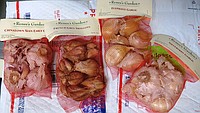Garlic is steeped in legend and has a long history. It is one of the oldest known food flavorings, and it is a culinary staple in many kitchens. Growing garlic at home is easy, and now is the time to start planting.
Instead of planting seeds, you plant individual cloves. Garlic produces a bulb-like structure called a head. Inside the head are a number of individual cloves.
While garlic can be planted in late winter or early spring, you will have a stronger harvest from cloves planted in the fall. The plants will start growing in the cool, moist weather, establishing a root system that will result in larger heads and an earlier harvest. Most garlic varieties need seven or eight months of growth before they are mature.
So, garlic is typically planted from October through early November and harvested in early summer.
Garlic plants thrive in our winters. They like cool weather and will overwinter unprotected most years. If temperatures are predicted to be crazy low (below zero Fahrenheit), add a light layer of mulch.
All true garlics are in the lily family, and garlic is a species in the onion genus, Allium sativum. They are closely related to onions, shallots, leeks and chives.
Photo Gallery
Garlic in your Garden
Quick tips and tricks for growing and harvesting garlic in your garden. Photos courtesy Janet B. Carson.
Many people only know the garlic bulbs they buy in the grocery store, but there are many varieties, which vary in size, color and flavor. Some are mild and some are hot.
Don't try to plant the garlic heads you buy in the produce section of the grocery store. Those could include varieties that are not well suited to our climate; and grocery-store garlic is usually treated to make its shelf life longer, and that can inhibit growth. Nurseries and garden centers carry garlic for planting.
When you buy garlic locally to plant, you are limited by the variety in our local outlets; but there are many mail-order companies that offer a wide range of options. Experiment with different kinds, and see which varieties you like best.
While there are many varieties of garlic, most fall under one of two types -- softneck and hardneck.
SOFTNECK
Softneck garlic (also called artichoke garlic) produces a soft flower stalk. It is the garlic you will find plaited into garlic braids.
The easiest of the garlics to grow, it will thrive in a variety of climates. It does not require low temperatures to produce, making it perfect for those who live in the South.
Softneck garlic typically produces smaller heads than hardneck garlic, but they contain more cloves than the hardneck varieties.

HARDNECK
Hardneck garlic (also called Porcelain garlic) produces a stiff flower stalk. The individual garlic cloves are larger than in softneck, but there are typically fewer cloves per bulb.
Most of the hardneck varieties also have a much hotter flavor, although there are some milder varieties as well.
Hardneck garlic is very cold tolerant, but even in Arkansas' milder winters it will grow well: The heads just won't get as large as hardnecks grown farther north.
Hardneck varieties also ripen a bit later than softneck varieties.
HOW TO PLANT
Choose your site. Garlic needs well-drained soil in full sun. Clean your site of any weeds or grass, and mix in some compost and complete fertilizer. Then plant the cloves.
Plant the cloves 3-5 inches apart and 2-3 inches deep, with the pointy end facing up.
We rarely see any diseases in garlic plantings, but it can happen. If you plant garlic every year and have had problems, you can treat your cloves. Some gardeners soak the cloves in a solution of baking soda and water (1 teaspoon per gallon) for an hour or so before planting. Others soak them in rubbing alcohol for a few minutes before planting.
I have never treated but I do inspect the cloves at planting.
Garlic prefers even watering during its growing season. Normally we have ample moisture during the winter. If the plants get too dry, it can make the flavor stronger at harvest time.
Fertilize at planting, and again in late March or early April as the plants kick in with green growth. Discontinue any fertilization when you see the bulbs beginning to form. Late fertilization can result in more leaves at the expense of bulb formation.
HARVEST TIME
If you are growing a lot of garlic, you can harvest immature bulbs or even foliage.
In late winter when the plants have at least five or six leaves, you can harvest some of the outer ones to use. In late spring, curly green stems called scapes form on hardneck varieties, and these also can be harvested and eaten. Both the foliage and the scapes have a sweet, mildly garlicky flavor and can be used like green onions or chives.
Harvested while young, immature garlic bulbs are the "green garlic" sold in farmers markets, and they usually have a mild flavor.
Different varieties will ripen at different times. In the South, if we get a quick, hot spring and early summer, garlic will bolt, signaling harvest time. A milder spring and early summer will delay ripening and allow for larger bulbs.
Garlic is ready to pick when the outer leaves have browned and dried and about five green leaves remain. Don't wait for all the leaves to die or the garlic can get overripe, which can lead to poor storage.
Pull the bulbs out of the ground and shake off as much dirt as possible. Then cure the bulbs by drying them for several weeks in a cool, dark spot with good air circulation. They are then ready to use.
Store the rest in a cool, dry place. They should last for months.
Janet Carson's blog is at arkansasonline.com/planitjanet.

